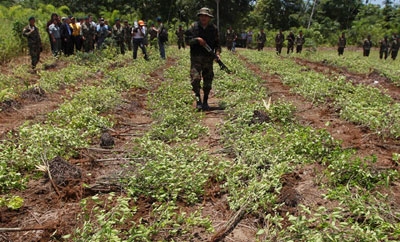Bolivia has destroyed 11,407 hectares of coca in 2013, surpassing its previous record by over 300 hectares, indicating that eradication has continued apace despite illicit coca growers’ attempts to slow the process.
Deputy Minister for Social Defense Felipe Caceres said the increase was achieved with the help of an additional $36 million put towards the eradication of illegal coca in 2013. The bulk of operations were carried out in the coca-growing regions of Los Yungas, La Paz; Chapare, Cochabamba; and Yapacani, Santa Cruz, reported La Razon. The country achieved record eradication in 2012, destroying 11,035 hectares.

While eradication is up, seizures of cocaine and coca base fell 42 percent compared to 2012, from 36.3 tons to 20.9 tons, according to the director of anti-narcotics police unit FELCN, Mario Centellas.
According to Centellas, the FELCN prioritized the detection of laboratories in the 13,264 operations carried out over the course of 2013, destroying 62 cocaine laboratories and 48 laboratories dedicated to the recycling of precursor chemicals.
InSight Crime Analysis
Earlier this year, the United Nations Office on Drugs and Crime (UNODC) reported that coca production in Bolivia dropped seven percent between 2011 and 2012, partly due to eradication efforts and partly to a drop in yield. The 2013 figures indicate that this trend is set to continue, despite anti-eradication uprisings by coca growers this year in the Apolo region of La Paz.
Much of the credit for this must lie with the President Evo Morales, who remains head of a major coca growers union. In contrast to eradication efforts in other coca producing countries, Morales has achieved reductions through negotiating with coca growers and working on establishing a legal market.
SEE ALSO: Coverage of Coca
However, the limitations of this approach were demonstrated by a recently published Bolivian government study, which found only 14,705 hectares of coca were needed to satisfy the country’s legal demand — some way below the 25,300 hectares produced in 2012.
The simultaneous drop in seizures is unsurprising, considering the country’s lack of radar technology to interdict rising drug flights. Former FELCN head Colonel Gonzalo Quezada, who was replaced earlier this year, tempered supply-side disadvantages by targeting production; an approach that appears to be continuing under Centellas.
Bolivia’s mixed successes come as Colombia has missed its 2013 coca eradication goals by half, sparking concerns of a renewed rise in production. Peru, meanwhile reported breaking its eradication record in 2013, but simultaneously emerged as the world’s biggest coca producer.

